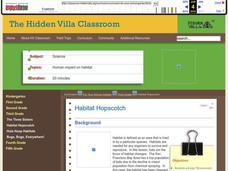Curated OER
Frogs
Students explore the external and internal structures of an amphibian and how frog anatomy compares to human anatomy. They collect pictures of a frog using a digital camera, create a web page, develop a PowerPoint presentation, and...
Curated OER
Alternative to the Frog Dissection
Students conduct internet research about frog anatomy and construct a journal that chronicles their explorations. They write descriptions of each system of the frog and the functions of the organs.
Curated OER
Frog Dissection
Students explore the anatomy of frogs. They complete a frog dissection to complete an accompanying worksheet which includes questions, diagrams and pictures.
Curated OER
Frog External Anatomy
Sixth graders study frog anatomy. In this frog anatomy lesson students examine a frog including the anatomy of its mouth and fill out a worksheet.
Curated OER
Hop To It!
Students explore the aspects of a frog's anatomy that allow it to be such a good jumper and jump and record the length of each jump to determine which style of jumping allows them to jump the farthest.
Curated OER
Amphibians-Frog Dissection
Students compare the anatomy of a fish to an amphibian and that of an amphibian (frog) to a human. They complete a virtual frog dissection to gain some experience prior to the real dissection.
Curated OER
Animal Movement in Water
Students explore oceanography by participating in field trip activities. In this fish characteristics lesson, students attend a trip to a local beach or reservoir and collect different specimens in order to examine them. Students...
Curated OER
Are You a Frog?
Students listen to the book "Ask Me If I'm a Frog, and compare their anatomy and habits to the anatomy and habits of a frog to identify with the characteristics unique to frogs. They respond to teacher-generated questions by writing...
Curated OER
Ribbit-Ouch!
Students investigate the anatomy of a frog using a virtual dissection tool in order to study the structures and organ as they relate to other animals.
Curated OER
Frogguts
Pupils comprehend the basic anatomy of the frog and prepare themselves for dissection. They work through the virtual dissection. Students complete the worksheet and begin to assemble the frog skeleton. They are assigned frog...
Curated OER
Animals
Second graders define and describe the characteristics of a mammal and a mammal's importance to man. They also describe the life cycle of a frog and compare and contrast a larva and an adult frog. Finally, 2nd graders study and explain...
Curated OER
Digital Dissections
Young scholars dissect organisms and take photographs to create a PowerPoint dissection library. In this anatomy lesson, students dissect organisms that interest them and photograph the process while identifying structures. They create a...
National Science Teachers Association
Hop into Action
Young scientists find out what makes amphibians such unique and interesting animals in this simple life science instructional activity. After looking at pictures and discussing the characteristics of amphibians, learners...
Curated OER
Amphibian Features - Frog Dissection
Seventh graders examine the physical features of an amphibian. In this investigative lesson students compare and contrast the anatomy of a frog to a human.
University of Minnesota
Sheep Brain Dissection
Bored with frog and earthworm dissections? Had your fill of fetal pigs? Anatomy students will be intrigued by the sheep's brain, and you will be prepared with guiding questions, extension activities, and pictures as they dissect one —...
Curated OER
Growing Eyeballs
Students investigate vision and the anatomy of the human eye. They complete a Webquest, watch a video about the structure of the eye, take an online quiz, answer discussion questions, and read newspaper articles about activities that...
Curated OER
The Skeletal System
Students identify bones off a skeleton during quizzes; assemble disarticulated skeletons; bird, frog and rat. They dissect frogs, remove the muscle tissue, and identify of bones.
Curated OER
Habitat Hopscotch
Third graders explore animal characteristics by participating in a bat environment game. In this natural habitat lesson, 3rd graders identify the physical anatomy of a bat and discuss their eating and sleeping habits. Students conduct a...
Curated OER
Alessandro Volta: The Invention of the Voltaic Pile (The First Electric Battery)
Students conduct a series of experiments on electricity. In this physics lesson, students study the work of Alessandro Volta particularly his experiment on the the Voltaic Pail. They build their own Voltaic Pile to recreate his experiment.
Other popular searches
- Frog Anatomy Powerpoint
- Middle School Frog Anatomy
- Frog Anatomy Patterns
- Frog Anatomy Worksheet
- Frog Anatomy Chart
- Frog Anatomy Virtual
- Anatomy of a Frog


















